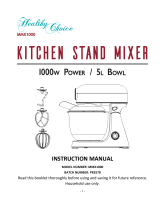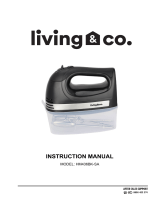
11
hints and tips
1. Before starting, read the recipe completely.
2. Refrigerated ingredients, i.e. butter and eggs should be at room temperature before
mixing begins. Set these ingredients out ahead of time. Cream is best when it is
whipped cold straight from the refrigerator.
3. Before starting your recipe, preheat the oven to the temperature recommended in the
recipe and gather all the ingredients and utensils near to the mixer.
4. Caster sugar is the preferred choice for cake making. Add it to the softened butter
and always cream until pale in colour.
5. To eliminate the possibility of shells or deteriorated/off eggs in your recipe, break
eggs into a separate container rst, then add to the mixture.
6. When mixing egg whites, be sure the bowls and beaters are thoroughly cleaned
and dried, as even the smallest amount of oil on beaters or bowl may cause the egg
whites not to aerate.
7. Your mixer always starts at a slow speed to prevent ingredients from being thrown
out of the bowl. During mixing, gradually increase the speed to the recommended
speed as required for the recipe.
8. Do not over beat. Be careful that you only mix/knead mixtures as recommended in
your recipe. Fold in dry ingredients until just combined. Always use the low speed.
At any stage of mixing, over beating can cause toughness, close texture, lack of
rising or excessive shrinkage. Climatic conditions, seasonal temperature changes,
temperature of ingredients and their texture variation from area to area all play a part
in the required mixing time and the results achieved.
9. All recipes have been kitchen tested, but should you nd it necessary to vary the
ingredients or size of the tin etc. allow for a variation in cooking time. Always ensure
that baked foods are correctly cooked before removing them from the oven or
cooking appliance.
10. During mixing, ingredients may be thrown upwards and adhere to the sides of the
bowl. To scrape the bowl, turn the mixer and bowl control dials to the ‘OFF’ position
and use the shaped spatula supplied. A light scraping after the addition of each
ingredient assists in achieving efcient mixing.
11. If you don’t have a tin the same size as the recipe suggests here are some
alternatives: two 20cm sandwich tins, one 28 x 18cm tin, one 20 x 7cm round cake
tin or a standard loaf tin.
12. Cooking times and temperatures are meant only as a guide. Light mixtures should
spring back when lightly touched and heavy mixtures, fruit cake and the like, should
be tested with a skewer towards the end of the suggested cooking time. If the skewer
is clean when removed, the cake is cooked.
























